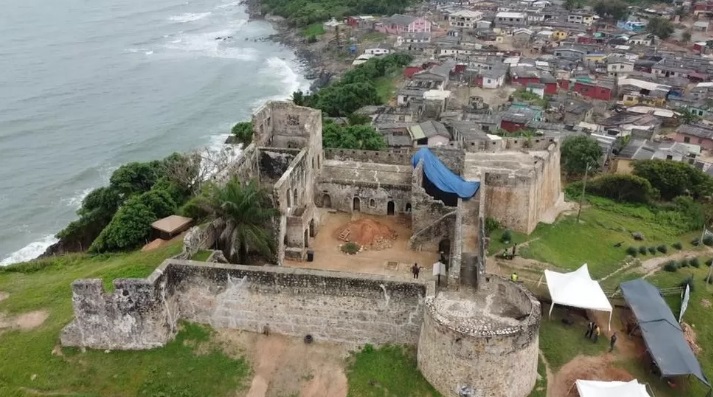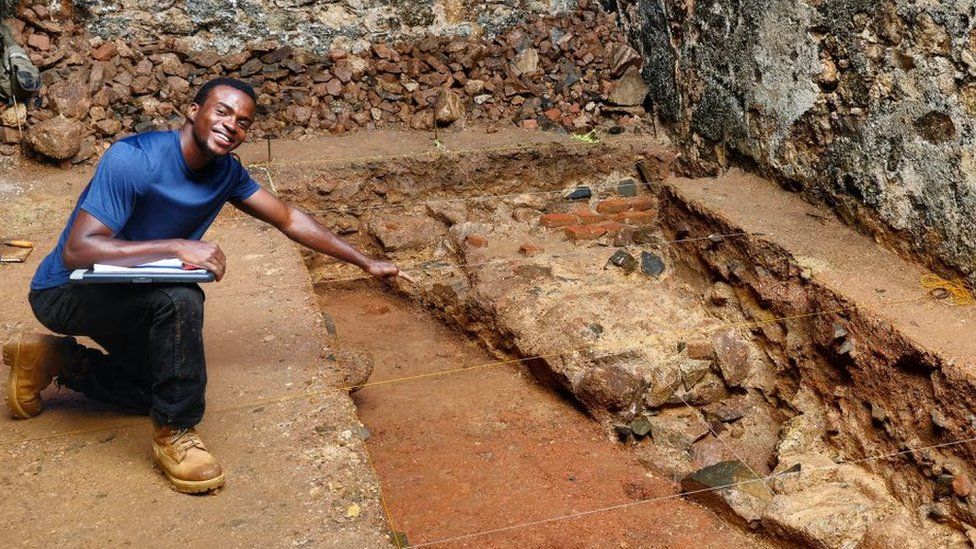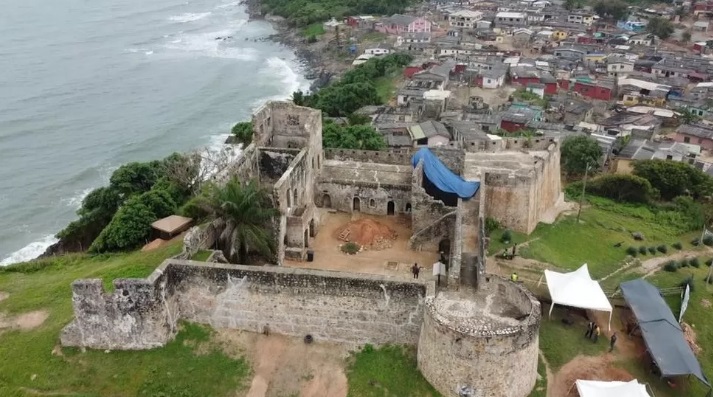Uncovered on Ghana’s coast is the “First English slave fort in Africa.”


The BBC has been hearing about the significance of the find in Ghana, which may have revealed the precise position of what is believed to be the first English slave fort in Africa.

Christopher DeCorse, an archaeologist, carefully spreads out the priceless artifacts on a temporary table near the excavation site.
The jawbone of a goat, tobacco pipes, shattered earthenware, and gunflint (used in vintage firearms) are all artfully arranged. These abandoned pieces, uncovered from millennia of compacted soil, provide hints about a vanished history.
The lecturer from Syracuse University in the US said with a big smile that “any archaeologist who says they are not excited when they find something is not being entirely truthful.”
He claims that these remains are evidence of “the first English outpost established anywhere in Africa.”
Speaking over the wind and the thunder of the Atlantic Ocean waves slamming Ghana’s shoreline, the archaeologist is standing in the Fort Amsterdam ruins.

The professor’s team is actively excavating what are believed to be the remains of an ancient fort called Kormantine that was lost beneath the ground inside that current fort.
With soft-bristle brushes and trowels, they are meticulously sifted through separate layers of soil and stones. The trenches’ disturbed dirt is properly sieved after removal.
The team and the site are covered from the elements, and the archaeologists continue their work despite the blazing sun and the sporadic downpour.
Ancient maps had referred to a Fort Kormantine in that area, for example, the name of the nearby town, Kormantse, is clearly related.
In addition, another version of the name, Coromantee, was given to some of the enslaved people in the Caribbean thought to have been transported from this place and later known for slave rebellions. But where exactly the fort was located remained a matter of speculation, which may have now been brought to an end.

Dating back to the 17th Century, Fort Kormantine sat on the Atlantic coast just at the time when Europeans started shifting their interest from the trade in gold to the trade in humans. It was a pivotal moment in the history of their involvement in Africa that would have a profound effect on the continent.
The archaeologists’ find may provide some insight into the activities of those early traders as well as those who were sold and their effects on the neighborhood.
The coastal fishing communities of Ghana, famous for their colorful boats and the tunes sung by the fisherman, are still marred by the atrocities committed by the Europeans and by wicked people in the past.
A looming reminder of that time is the slave forts scattered over the area formerly known as the Gold Coast.
Before being carried across the sea in appalling circumstances, hundreds of thousands went through them.
One of the early locations where that voyage began was Fort Kormantine, which the English built-in 1631.
It started off as a trading post for goods like ivory and gold.
Only in 1663, when King Charles II issued a charter to the Company of Royal Adventurers of England Trading into Africa (becoming the Royal African Company), did the slave trade start from that point on. He granted it exclusive control over the trade of people.
Fort Kormantine was only in English hands for two more years before the Dutch took control of it, but during that time, it was crucial in the development of the slave trade.
It served as a storage facility for the things used to purchase slaves. It served as a temporary detention facility for people who had been abducted in various regions of West Africa before being transported to the Caribbean to work on plantations to advance the sugar industry.
One of the factors that make locating Fort Kormantine’s foundations interesting, according to Prof. DeCorse, is the lack of information regarding the actual appearance of these early slave trafficking outposts.
The Dutch constructed Fort Amsterdam on the same position as the fort after taking control of it, so its precise location could not be determined, especially after it was designated a United Nations World Heritage Site, which made excavation challenging.
However, preliminary excavations in 2019 in and around Fort Amsterdam, which uncovered some early 17th Century artifacts, provided a possible location.
Early this year, archaeologists visited the area again and started further investigations.
As they began by discovering numerous plastic items that must have been dropped more recently, there was first some dismay. But later a stone that Professor DeCorse identified as a component of a larger construction was discovered by Nigerian graduate student Omokolade Omigbule.
The University of Virginia student describes seeing the remains and the footprints of an actual building that had been buried beneath a new fort as “mind-blowing.”
“Being a part of such a dig takes me back a few hundred years, it feels like I was there,” the participant said of seeing the effects of these outside forces in Africa firsthand.
A six-meter (20-foot) wall, a door post, foundations, and a drainage system made of red brick were discovered as the excavations went on.
All these indicate an English presence pre-dating the Dutch fort. Returning to the display of artifacts in neatly labeled zip-lock bags, Prof DeCorse points out the rusty gunflint, which he says was in use in England in the early 17th Century.
The pipes with their small bowls where the tobacco was placed “is also very distinctive of the time that we are talking about here”, the professor says, adding that over time the bowls got larger as tobacco became cheaper and more readily available. Pre-empting the question about why the jawbone of a goat is important, Prof DeCorse suggests that it is proof of how the English occupants may have domesticated local animals as an alternative source of protein despite being on a coastline where there were fish in abundance.
Work in archaeology is laborious. Each historical relic that it produces must be questioned and analyzed.
The hard work has, however, really only begun in some ways. Over the course of the next three years, archaeologists will work to understand Fort Kormantine’s whole scope, including its architecture and overall aesthetic. This should help them understand its genuine significance.
credit: BBC







